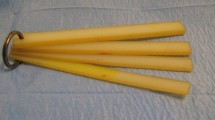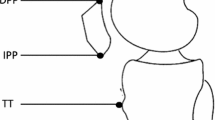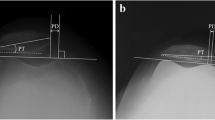Abstract
Purpose
This study used magnetic resonance imaging (MRI) to evaluate in vivo preoperative changes in the length of the patellar tendon (LPT) in patients undergoing total knee arthroplasty (TKA). We sought to answer two questions: first, does the LPT change with flexion? Second, does the LPT show a gender-specific pattern?
Methods
Eighty-five knees in 76 consecutive osteoarthritic patients were evaluated. The age range was 56–90 years (mean 70). The study included 62 females and 14 males. MRI was performed at full extension and at 30°, 60°, 90°, and full flexion.
Results
There were significantly different patterns between genders (p < 0.001). The main shortenings occurred earlier, at 30°, in females and later, at 60°, in males. In females, LPT values in full extension were significantly longer than those measured at other flexion angles. In male subjects, significant differences in LPT values were found between full extension versus 90° (p < 0.001) and full flexion (p < 0.001), and between 60° versus 90°(p = 0.030) and full flexion (p = 0.030).
Conclusion
These differences might influence the gender-specific complications related to the extensor mechanism after TKA. These data provide useful information for surgeons attempting to achieve a satisfactory balance between joint gaps in the patellar reduced position intraoperatively.



Similar content being viewed by others
References
Brilhault J, Ries M. Measuring patellar height using the lateral active flexion radiograph: effect of total knee implant design. Knee. 2010;17:148–51.
Meneghini RM, Ritter MA, Pierson JL, Meding JB, Berend ME, Faris PM. The effect of the Insall-Salvati ratio on outcome after total knee arthroplasty. J Arthroplasty. 2006;21(Suppl 2):116–20.
Lemon M, Packham I, Narang K, Craig DM. Patellar tendon length after knee arthroplasty with and without preservation of the infrapatellar fat pad. J Arthroplasty. 2007;22:574–80.
Weale AE, Murray DW, Newman JH, Ackroyd CE. The length of the patellar tendon after unicompartmental and total knee replacement. J Bone Joint Surg [Br]. 1999;81:790–5.
Dennis DA, Kim RH, Johnson DR, Springer BD, Fehring TK, Sharma A. Control-matched evaluation of painful patellar crepitus after total knee arthroplasty. Clin Orthop Relat Res. 2011;469:10–7.
Carroll CC, Dickinson JM, Haus JM, Lee GA, Hollon CJ, Aagaard P, Magnusson SP, Trappe TA. Influence of aging on the in vivo properties of human patellar tendon. J Appl Physiol. 2008;105:1907–15.
DeFrate LE, Nha KW, Papannagari R, Moses JM, Gill TJ, Li G. The biomechanical function of the patellar tendon during in vivo weight-bearing flexion. J Biomech. 2007;40:1716–22.
Yoo JH, Yi SR, Kim JH. The geometry of patella and patellar tendon measured on knee MRI. Surg Radiol Anat. 2007;29:623–8.
O’Brien TD, Reeves ND, Baltzopoulos V, Jones DA, Maganaris CN. Mechanical properties of the patellar tendon in adults and children. J Biomech. 2010;43:1190–5.
Onambélé GN, Burgess K, Pearson SJ. Gender-specific in vivo measurement of the structural and mechanical properties of the human patellar tendon. J Orthop Res. 2007;25:1635–42.
Aglietti P, Buzzi R, Insall JN. Disorders of the patellofemoral joint. In: Insall JN, Scott WN, editors. Surgery of the Knee, vol. 1. New York: Churchill Livingstone; 2001. p. 913–1043.
Aglietti P, Insall JN, Walker PS, Trent P. A new patella prosthesis: design and application. Clin Orthop Relat Res. 1975;107:175–87.
Hull ML, Berns GS, Varma H, Patterson HA. Strain in medial collateral ligament of the human knee under single and combined loads. J Biomech. 1996;29:199–206.
Whiteside LA, Saeki K, Mihalko WM. Functional medial ligament balancing in total knee arthroplasty. Clin Orthop Relat Res. 2000;380:45–57.
Noyes FR, Bulter DL, Grood ES, Zernicke RF, Hefzy MS. Biomechanical analysis of human ligament grafts used in knee-ligament repairs and reconstructions. J Bone Joint Surg [Am]. 1984;66A:344–52.
Almekinders LC, Vellema JH, Weinhold PS. Strain patterns in the patellar tendopathy. Knee Surg Sports Traumatol Arthrosc. 2002;10:2–5.
Ayers DC, Dennis DA, Johnanson NA, Pellegrini VD Jr. Instructional course lectures, the American Academy of Orthopaedic Surgeons: common complications of total knee arthroplasty. J Bone Joint Surg [Am]. 1997;79A:278–311.
Sharkey PF, Hozack WJ, Rothman RH, Shastri S, Jacoby SM. Why are total knee arthroplasties failing today? Clin Orthop Relat Res. 2002;404:7–13.
Meding JB, Fish MD, Berend ME, Ritter MA, Keating EM. Predicting patellar failure after total knee arthroplasty. Clin Orthop Relat Res. 2008;466:2769–74.
Gejo R, Morita Y, Matsushita I, Sugimoto K, Kimura T. Joint gap changes with patellar tendon strain and patellar position during TKA. Clin Orthop Relat Res. 2008;466:946–51.
Matsumoto T, Muratsu H, Tsumura N, Mizuno K, Kuroda R, Yoshiya S, Kurosaka M. Joint gap kinematics in posterior-stabilized total knee arthroplasty measured by a new tensor with the navigation system. J Biomech Eng. 2006;128:867–71.
Matsumoto T, Muratsu H, Tsumura N, Mizuno K, Kuroda R, Kurosaka M. Soft tissue balance measurement in posterior-stabilized total knee arthroplasty with a navigation system. J Arthroplasty. 2009;24:358–64.
Insall JN, Easley ME. Surgical techniques and instrumentation in total knee arthroplasty. In: Insall JN, Scott WN, editors. Surgery of the knee, vol. 2. New York: Churchill Livingstone; 2001. p. 1553–620.
Sasaki H, Kubo S, Matsumoto T, Muratsu H, Matsushita T, Ishida K, Takayama K, Oka S, Kurosaka M, Kuroda R. The influence of patella height on intra-operative soft tissue balance in posterior-stabilized total knee arthroplasty. Knee Surg Sports Traumatol Arthrosc. 2012;20:2191–6.
MacDonald SJ, Charron KD, Bourne RD, Naudie DD, McCalden RW, Rorabeck CH. The John Insall Award: gender-specific total knee replacement. Prospectively collected clinical outcomes. Clin Orthop Relat Res. 2008;466:2612–6.
Ritter MA, Wing JT, Berend ME, Davis KE, Meding JB. The clinical effect of gender on outcome of total knee arthroplasty. J Arthroplasty. 2008;23:331–6.
Author information
Authors and Affiliations
Corresponding author
About this article
Cite this article
Ishii, Y., Noguchi, H., Takeda, M. et al. Impact of knee flexion on patella length in osteoarthritic patients undergoing total knee arthroplasty. J Orthop Sci 18, 547–551 (2013). https://doi.org/10.1007/s00776-013-0377-2
Received:
Accepted:
Published:
Issue Date:
DOI: https://doi.org/10.1007/s00776-013-0377-2




